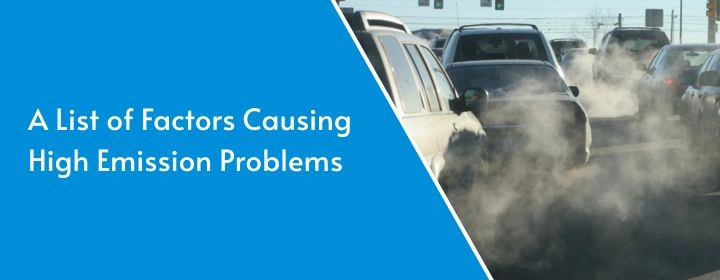
A List of Factors Causing High Emission Problems
High emissions are one of the top reasons that a car fails the state inspection. If your vehicle doesn’t pass the test, then your vehicle might be producing too much pollution, burning the fuel more than normal, or the emission control system isn’t working properly. These issues are the signs of wear inside the engine, or there is a problem with the fuel delivery and ignition. This isn’t just about passing a test; high emission problems mean your engine is wasting fuel and polluting more than it should. Let’s go through the common causes, starting with the ones most mechanics check first.
1. Oxygen Sensor Issues
Oxygen sensors read oxygen levels in exhaust gases. If the readings are wrong, your ECU sends either too much or too little fuel. Too rich means expect more unburned fuel and higher HC and CO levels. Too lean means NOx emissions climb.
Bad sensors are pretty common, especially after 80 to 100k miles. If your check engine light is on with codes like trouble codes, this is one of the first places to look.
2. Fuel Injector Problems
A clogged injector won’t spray fuel evenly. A leaking one dumps excess fuel into the cylinder. Either way, combustion suffers. You might notice rough idling, bad fuel economy, or a fuel smell from the exhaust.
Regular injector cleaning can help, but if one’s mechanically worn or damaged, replacement is the only option.
3. Dirty or Blocked Air Filter
When an air filter is packed with dirt, airflow drops. Less air means a rich mixture — that’s more fuel than the engine can burn completely, so emissions rise. Changing the filter is cheap, easy, and can instantly improve air-fuel balance.
4. Catalytic Converter Failures
The catalytic converter helps in converting the dangerous gases into less dangerous but when it gets damaged or clogs then it doesn’t keep the emissions in check. The symptoms of catalytic converter failures are rotten egg smell, power loss, or noise. Replacement is the fix; cleaning doesn’t work in most cases.
5. Worn Spark Plugs
If plugs can’t create a strong spark, you’ll get incomplete combustion. That means more unburned fuel in the exhaust. Rough idle and hard starts often go with this. Swapping in the correct type of plug, properly gapped, can fix the issue.
6. Ignition Timing Off
If timing’s too advanced or too retarded, combustion happens at the wrong time. That throws off efficiency and emissions. Modern cars adjust timing automatically, but sensor problems or bad timing chains can still cause trouble.
7. EVAP System Leaks
The evaporative emissions system traps the fuel vapors, but a cracked hose or faulty purge valve lets the vapors leak. Often, you won’t notice until the check engine light comes on with an EVAP code.
8. Vacuum Leaks
A vacuum leak allows unmetered air to enter the engine. This leans out the mixture, raising NOx emissions. You might notice a strange noise, and the common spots where air enters are the intake manifold gaskets, vacuum hoses, and brake booster lines.
9. Overheating Engine
High combustion temperature creates more NOx. If your car is running hot, then you must check the coolant levels, thermostat, water pump, and radiator. Fixing overheating can bring NOx levels back to normal.
10. Oil
Blue smoke from the exhaust means oil is getting into the combustion chamber, which creates the particulate emissions and can damage the catalytic converter. Worn piston rings or valve seals are often the cause.
11. Mass Air Flow Sensor Issues
If the Mass Air Flow is dirty or failed, then it sends bad air airflow to the ECU, which throws the fuel delivery and can make the emissions worse. Cleaning with MAF-safe spray sometimes helps; other times, replacement is necessary.
12. EGR System Malfunctions
The EGR system recirculates exhaust gas to lower combustion temperatures and cut NOx. If it’s stuck shut, NOx spikes. If it’s stuck open, HC levels rise, and idle gets rough.
13. Fuel Pressure Wrong
High fuel pressure is equal to rich running. Low pressure is equal to lean running. Either one of them has trouble with emissions. It can cause bad pumps, regulators, or even clogged filters.
14. Poor Fuel Quality
Low-grade quality fuel builds the carbon that deposits in the engine and exhaust, and this affects the efficiency of the catalytic and combustion.
Keeping Emissions in Check
If you don’t want high emission problems, then maintaining it is the only solution you have:
- You need to replace air filters, spark plugs, and oxygen sensors.
- Use quality fuel.
- Keep the cooling system in good shape.
- Don’t ignore the check engine light, scan it, and fix the root cause.
Even small problems like a dirty MAF or a tiny vacuum leak can push your numbers high enough to fail an emissions test.
Conclusion
From the above gist, we conclude that high emissions aren’t random; there is always a reason behind them. It could be a minor issue, like a dirty air filter, or a major issue like internal engine wear. The sooner you detect it, the less damage you’ll do to your wallet and the environment. If you see the check engine light, smell fuel from the exhaust, or notice that your vehicle is performing poorly, don’t wait for the inspection to fail. Get it checked now. Fixing high-emission problems early keeps your car efficient, helps it pass the test, and keeps harmful gases out of the air.
